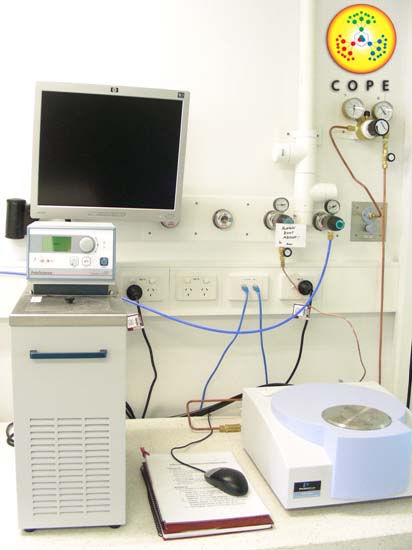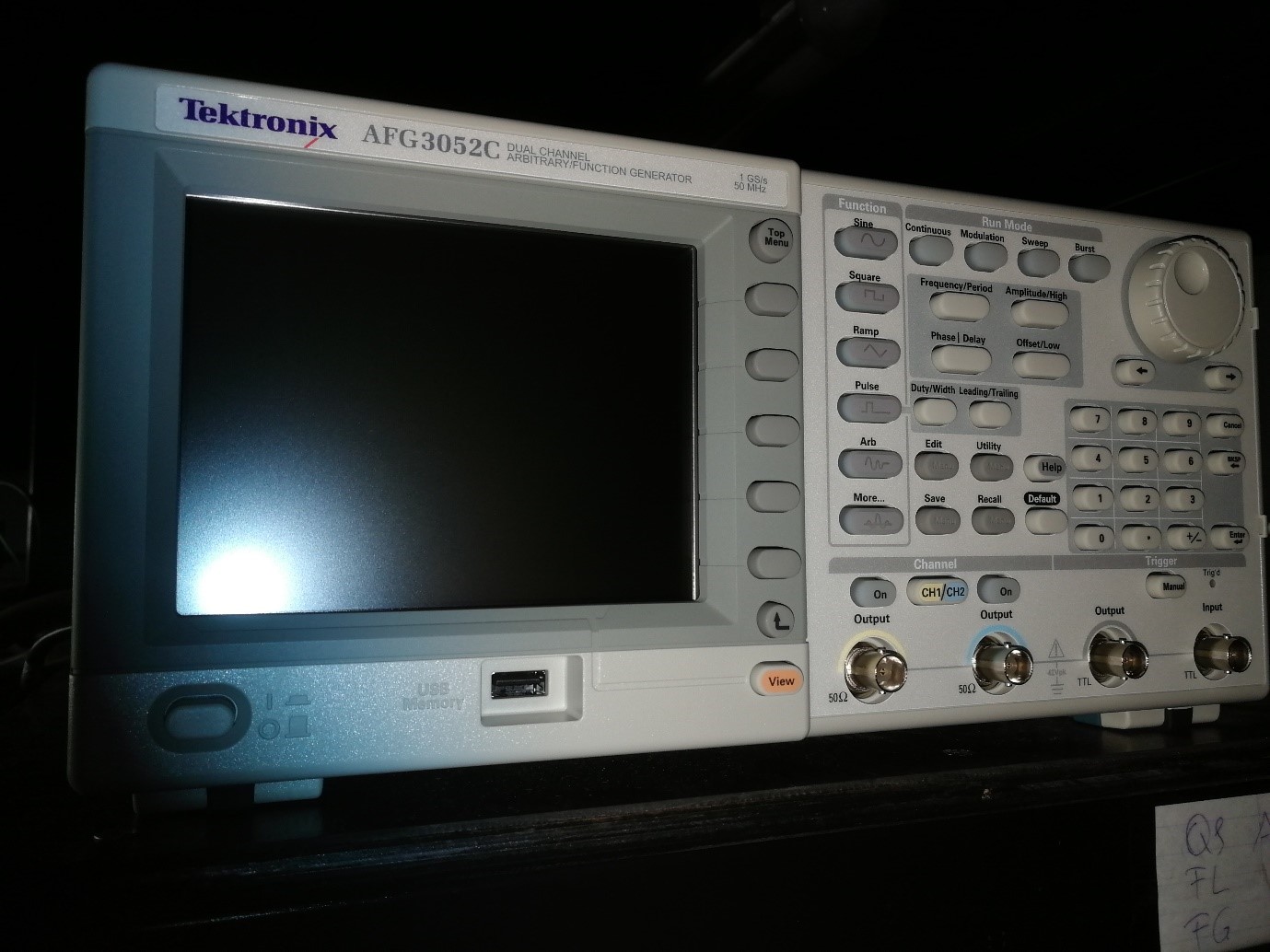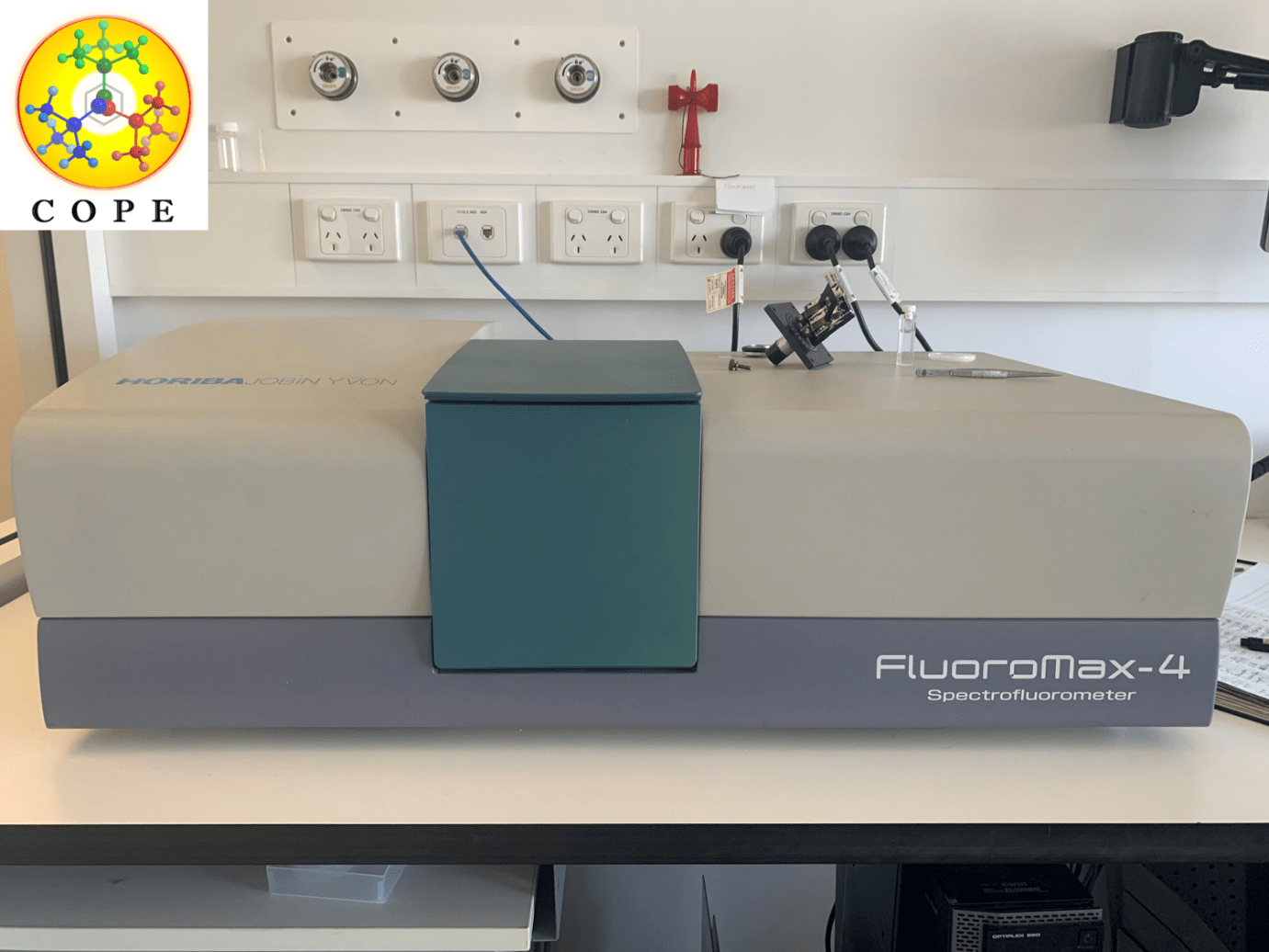COPE And ANFF-Q Analytical Facilities
The world-class COPE and ANFF-Q analytical facilities are comprised of the following instrumentation:
Perkin-Elmer Spectrum 100 FT-IR Spectrometer

This instrument is a bench top FT-IR spectrometer that can handle both solid and liquid IR samples. Its working range is 7800-370cm-1, with a resolution of 0.5cm-1. The instrument is equipped with a Universal ATR accessory for attenuated total reflection fourier transform infrared spectroscopy.
Perkin-Elmer STA 6000 Simultaneous Thermal Analyser
 The STA 6000 is a combined Thermogravimetric Analyser and Differential Scanning Calorimeter. Its SaTurnA sensor combines measurement of both sample and reference temperatures allowing measurement of heat flow into a sample ensuring a thermogravimetric analysis procedure. It can measure from 15oC to 1000oC per minute and can purge with both N2 and air.
The STA 6000 is a combined Thermogravimetric Analyser and Differential Scanning Calorimeter. Its SaTurnA sensor combines measurement of both sample and reference temperatures allowing measurement of heat flow into a sample ensuring a thermogravimetric analysis procedure. It can measure from 15oC to 1000oC per minute and can purge with both N2 and air.
Perkin-Elmer Diamond Differential Scanning Calorimeter
 The Diamond DSC is a power-compensation differential scanning calorimeter; the sample and reference pans are heated by two independent furnaces embedded in a temperature-controlled heat sink. It supports modulated temperature DSC, standard DSC and Hyper DSC (temperature gradient less than 300oC.)
The Diamond DSC is a power-compensation differential scanning calorimeter; the sample and reference pans are heated by two independent furnaces embedded in a temperature-controlled heat sink. It supports modulated temperature DSC, standard DSC and Hyper DSC (temperature gradient less than 300oC.)
Agilent 1260 Infinity II Liquid Chromatography System

Our Agilent LC system has been configured for gel permeation chromatography. This instrument measures the molecular weight and polydispersity of analytes according to their size, using polystyrene standards. We have three sets of columns for this instrument: one set for a broad range of molecular weights (2,000 - 40,000,000, Mixed A columns), one high resolution set for measuring small molecules (up to 30,000, Mixed E columns), and an Infinitylab Poroshell 120 column for HPLC applications. This instrument detects compounds using a variable wavelength detector. Our standard operating conditions are a flow rate of 0.5 ml/min at 40°C with THF as the solvent.
BASi Epsilon EC-3
 The suitability of a material for an electronic device is dependent in part on the redox potential. Electrochemistry and especially Cyclic Voltammetry (CV) are powerful methods for obtaining information about the redox potentials (and stability) of organic semiconductor materials. The electrochemical processes occur at the electrode-solution interface and the CV measurement is based on a linear scan of the applied potential at the working electrode using a triangular potential waveform; the current response is measured and plotted against the applied potential.
The suitability of a material for an electronic device is dependent in part on the redox potential. Electrochemistry and especially Cyclic Voltammetry (CV) are powerful methods for obtaining information about the redox potentials (and stability) of organic semiconductor materials. The electrochemical processes occur at the electrode-solution interface and the CV measurement is based on a linear scan of the applied potential at the working electrode using a triangular potential waveform; the current response is measured and plotted against the applied potential.
Buchi Melting Point B-545
 This instrument allows determination of sample melting point, melting range and boiling point up to 400oC with high measuring accuracy. The apparatus is designed to be operated with ease, featuring a large sample observation window and intuitive control buttons, as well as high speed heating (20oC/min) and fan cooling to assist in rapid acquisition of data. The device also has built in memory for 10 methods as well as RS-232 communication interface and capability of data transfer via PC software.
This instrument allows determination of sample melting point, melting range and boiling point up to 400oC with high measuring accuracy. The apparatus is designed to be operated with ease, featuring a large sample observation window and intuitive control buttons, as well as high speed heating (20oC/min) and fan cooling to assist in rapid acquisition of data. The device also has built in memory for 10 methods as well as RS-232 communication interface and capability of data transfer via PC software.
Cary 5000 UV-Vis Spectrophotometer
 The Cary 5000 has a wavelength range of 175 - 3300 nm, contains an optical isolation system (a 'floating' solid aluminium casting that isolates the optics from external disturbances), PbSmartTM technology that optimizes the performance of the PbS NIR detector in real time, Schwarzchild coupling optics to ensure the maximum level of light throughput (this produces more accurate measurements at low transmission levels), silica overcoating to protect the optics from the environment and allows cleaning without damage to their reflective surfaces, variable and fixed slits to allow optimum control over data resolution (the spectral bandwidth can be set down to 0.01 nm and the slits can be fixed in the NIR as well as the UV-Vis regions), and an out-of-plane Littrow monochromator that minimizes photometric noise and stray light, providing excellent resolution.
The Cary 5000 has a wavelength range of 175 - 3300 nm, contains an optical isolation system (a 'floating' solid aluminium casting that isolates the optics from external disturbances), PbSmartTM technology that optimizes the performance of the PbS NIR detector in real time, Schwarzchild coupling optics to ensure the maximum level of light throughput (this produces more accurate measurements at low transmission levels), silica overcoating to protect the optics from the environment and allows cleaning without damage to their reflective surfaces, variable and fixed slits to allow optimum control over data resolution (the spectral bandwidth can be set down to 0.01 nm and the slits can be fixed in the NIR as well as the UV-Vis regions), and an out-of-plane Littrow monochromator that minimizes photometric noise and stray light, providing excellent resolution.
Speciality Coating Systems (Model G3-8)
 The unit allows spin coating of organic materials onto an appropriate substrate e.g. glass, silicon, PDMS. A vacuum chuck holds the substrate coated with solutions of material which is then spun at precise speeds for controlled periods of time. The device is capable of spinning speeds up to 9999 rpm for 999 s. By modulating the spinning speed and duration, the thickness of the films being cast can be varied to best suit the application under scrutiny. The user can also control the ramp-up and ramp-down time allowing complete control over the spinning conditions for the full duration of the spin cycle.
The unit allows spin coating of organic materials onto an appropriate substrate e.g. glass, silicon, PDMS. A vacuum chuck holds the substrate coated with solutions of material which is then spun at precise speeds for controlled periods of time. The device is capable of spinning speeds up to 9999 rpm for 999 s. By modulating the spinning speed and duration, the thickness of the films being cast can be varied to best suit the application under scrutiny. The user can also control the ramp-up and ramp-down time allowing complete control over the spinning conditions for the full duration of the spin cycle.
Dektak (150 Profilometer)
 The Dektak is used to measure the thickness or roughness of thin films, in the nanometer range with high repeatability. The Dektak has a large stage where a sample is placed underneath a stylus. The stage has an X-Y movement of approximately 2 inches. A 640 x 480-pixel (1/3 inch format) USB video camera is fitted with a fixed magnification, with an adjustable light source to help when viewing samples with different reflectivity. The stylus has a diamond tip which is moved over the surface of a material electromechanically taking measurements of the sample moving underneath it. As the sample is moved the stylus is moved over the surface, making vertical movements. As it does this, an electrical signal corresponding to the vertical movement of the stylus is produced, allowing for measurement of film thickness/roughness. This method allows for highly accurate and reproducible measurements in two dimensions. This can take scans up to 55 millimetres in length and can accommodate for samples up to 4 inches in thickness. The Dektak can also be programmed to make a three dimensional map of a surface to allow for viewing of film roughness over an area of the film.
The Dektak is used to measure the thickness or roughness of thin films, in the nanometer range with high repeatability. The Dektak has a large stage where a sample is placed underneath a stylus. The stage has an X-Y movement of approximately 2 inches. A 640 x 480-pixel (1/3 inch format) USB video camera is fitted with a fixed magnification, with an adjustable light source to help when viewing samples with different reflectivity. The stylus has a diamond tip which is moved over the surface of a material electromechanically taking measurements of the sample moving underneath it. As the sample is moved the stylus is moved over the surface, making vertical movements. As it does this, an electrical signal corresponding to the vertical movement of the stylus is produced, allowing for measurement of film thickness/roughness. This method allows for highly accurate and reproducible measurements in two dimensions. This can take scans up to 55 millimetres in length and can accommodate for samples up to 4 inches in thickness. The Dektak can also be programmed to make a three dimensional map of a surface to allow for viewing of film roughness over an area of the film.
Photoluminescence Quantum Yield (PLQY) Measurements of Organic Films
 The PLQY is the ratio of the number of photons emitted to photons absorbed and is a measure of how luminescent an organic material is. A HeCd laser (IK series, manufactured by Kimmon) is used to excite the organic material, which is kept within an integrating sphere (manufactured by SphereOptics.) The emission from thin films is anisotropic and the internal scattering coating of the integrating sphere redistributes it, enabling a reliable measurement of the organic material's total emission. This experimental setup is an essential tool in the characterization of organic semiconductors and allows greater understanding of the factors that influence a material's capacity for light emission.
The PLQY is the ratio of the number of photons emitted to photons absorbed and is a measure of how luminescent an organic material is. A HeCd laser (IK series, manufactured by Kimmon) is used to excite the organic material, which is kept within an integrating sphere (manufactured by SphereOptics.) The emission from thin films is anisotropic and the internal scattering coating of the integrating sphere redistributes it, enabling a reliable measurement of the organic material's total emission. This experimental setup is an essential tool in the characterization of organic semiconductors and allows greater understanding of the factors that influence a material's capacity for light emission.
Solar Cell Measurement Suite
 Solar simulators are specialised light sources that to good approximation have a similar irradiance to that of the sun. This allows for consistent characterization of a solar cell device's solar power conversion efficiency, which can reliably be compared to other research groups around the world. The solar simulator has its output beamed through a quartz window into a nitrogen filled glovebox that has low water and oxygen levels to enable measurements to be undertaken on unencapsulated devices.
Solar simulators are specialised light sources that to good approximation have a similar irradiance to that of the sun. This allows for consistent characterization of a solar cell device's solar power conversion efficiency, which can reliably be compared to other research groups around the world. The solar simulator has its output beamed through a quartz window into a nitrogen filled glovebox that has low water and oxygen levels to enable measurements to be undertaken on unencapsulated devices.
I-V Data Acquisition System
- Voltage ranges approximately 2.0 and approximately 10 V
- Current range 1 A
- Computes solar cell parameters: Voc, Isc, Jsc, Vmax, Imax, Pmax, and efficiency
- Measures light and dark I-V characteristics
- 4-wire interface to test device mounting and contacting fixture
Charge Transport Measurement
Our setup for measuring charge transport in organic systems consists of an oscilloscope (Waverunner 6200A), two function generators (Agilent 33250A, Tektronix 3052C), a voltage amplifier (Falco Syestems WMA-320), and three lasers (Opotek Inc 410-2200 nm, Quantel Brio 532 nm and Laserver 532 nm).



This facility can be used for various measurement techniques such as:
- Photo induced Charge Extraction by Linearly Increasing Voltage (Photo-CELIV)
Photo-CELIV provides us with average charge carrier mobilities in disordered organic semiconductors. A laser pulse serves as source of excitation to generate the charge carriers which are then extracted by linearly increasing voltage pulse produced by the function generator. The output transients are recorded by the oscilloscope, which are further analysed to estimate the mobilities. Varying the delay time between the laser and voltage pulses allows us to study the bimolecular recombination in organic opto-electronic devices.
- Metal Insulator Semiconductor structure based CELIV (MIS-CELIV)
MIS-CELIV enables us to selectively measure either hole or electron mobilities in either solution-processed or vacuum thermally evaporated films, with thicknesses close to those used in operational devices (~100 nm). This technique relies on the extraction of charge carriers that are injected by the voltage pulse. In addition, a voltage amplifier could be used to measure materials with low mobilities (<10-6 cm2V-1s-1).
- Time of flight (TOF)
The TOF technique was developed study the drift mobility in non-crystalline molecular solids. In this technique, the transit time of photogenerated charge carriers drifting through a sample of known thickness is determined under a constant applied electric field. This technique requires typically thicker films than working devices.
- Intensity dependent photocurrents
This technique allows us to estimate the photocurrents from organic opto-electronic devices or a range of input light intensities (5 orders of magnitude). A series of neutral density filters (Thorlabs and Holmarc) are used to vary the intensity of light produced by a specific wavelength laser pulse.
Vapour Generator
The Owlstone (V-OVG) Vapor Generator, is capable of generating NIST traceable, precise, repeatable, and accurate concentrations of chemicals and calibration gas standards. The V-OVG is a versatile platform for the calibration of industrial and scientific gas sensors. The V-OVG is paired with a Flame Spectrometer, Ocean Optics excitation source, and custom titanium sample chamber to enable measurements in the presence of hazardous materials.

Steady-state Spectrofluorometer

The Fluorolog®-3 is a unique, modular system which allows the researcher to interchange a wide range of accessories to correspond precisely with the characteristics of a given sample. From analysis of steady-state or molecular dynamics to IR probes, the Fluorolog®-3 comes equipped with a wide range and limitless configuration of accessories to enhance the accuracy and speed of it’s performance. Gas measurements are also possible using the flow controller and custom made sample chambers.
- Excitation 220-600 nm
- Emission 290-580 nm
- Resolution 0.3 nm
- Accuracy ±0.5 nm
Bench Top Spectrofluorometer

FluoroMax-4 is the latest generation of the FluoroMax series, which is a compact bench-top spectrofluorometer offering extended performance with high detection sensitivity. The FluoroMax series spectrofluorometers are ideal for measuring solid and liquid samples.
The FluroMax-4 features:
- Water Raman signal-to-noise ratio: 16000:1 (6000:1 FSD)
- Fast Scanning capability - up to 80 nm/second
- Phosphorimeter accessory for long-lived luminescence determinations
- Method Files to recall complete experiment parameters
- Offers excitation and emission spectra measurements as well as kinetic measurements
- Excitation range 300-900 nm (corrected between 240 – 600 nm)
- Emission range 300 – 900 nm (corrected between 290 – 850 nm)
- Bandpass 0- 30 nm, continuously adjustable
- Integration time 1 ms – 160 s
